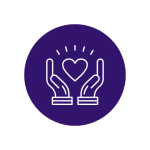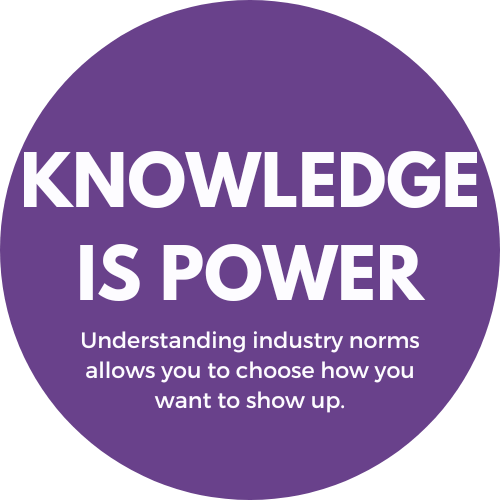
4 Parts of Professionalism

Cultivate savvy interpersonal skills that allow you to effectively share your message both verbally and in writing.

“Follow through on your verbal and written communications.” Practice good time-management in order to punctually follow through on commitments.

“Showing up with dedication. Being present both physically and mentally.” “Demonstrate investment” in the organization by being engaged (may be indicated by eye contact, body language, active listening, asking questions, etc).

“Respecting everyone, of differing backgrounds and cultures, in the workspace.” Refrain from harmful gossip.
Professional Norms
- Effective Communication
- Reliability
- Dress Codes: Decoded
- Industry Code of Ethics & Guidelines
-
Professional Email Communication
Since the start of the COVID-19 pandemic, email has become a crucial component of workplace conversations. Thus, it has become increasingly important to become comfortable with communicating on this medium.
Flowrite has great article on common email etiquette that will help you writing emails in professional settings, including sending emails to faculty, staff, supervisors, or colleagues.
Email SignatureYour email signature, at minimum should include:
- Your Full Name
- Pronouns (If Comfortable)
- Your title and/or major
- St. Catherine University (If Student); Employer (If no longer student)
- Your email and phone number
Click here for ideas and templates.
Email vs. Other Virtual CommunicationIt is important to distinguish the difference between email communication, and “chat-style” communication, such as on Google Chat, Microsoft Teams, or common communication apps such as Slack. Often, these forms of communication will have their own distinct norms based on the office you work in. For example, some workplaces may send emojis and GIFs, while others may use full punctuation. If you are unsure of the tone you should use in these formats, try asking a colleague or your supervisor for guidance.
-
The idea of being “timely” and “punctual” will vary across fields. When first starting at an organization, or when you are in the job-search process, it is recommended that you be aware of how your timeliness may reflect on you. As a general rule of thumb, try to arrive 5 minutes before the start time of a meeting or interview, unless stated otherwise.
Once you are established in your position, there may be flexibility depending on what industry you’re in. Some jobs depend on a rigid schedule; in healthcare, for example, showing up late to assist in a surgery will not be taken lightly. However, other jobs may have built-in flexibility; your office job may not mind if you start 30 minutes late, so long as you get your work complete.
It is important to note that some folks, especially in the United States, view timeliness as a sign of respect. It is important to ensure that you are cognizant of your timeliness until you know the norms of your organization.
-
The Washington Center has a great article on how to navigate figuring out what the dress code is in the workplace, and what people mean when they say phrases like “business casual.”
If you do not currently have professional clothing, visit Katie’s Closet to get free, professional clothing!
-
Professional Code of Ethics are sets of guidelines and expectations set up by professional associations to outline moral and ethical codes of conduct for a specific job and/or industry. It includes information on how to approach specific situations, protect individual rights, and avoid causing harm to those who you work for and with. A few examples include: National Association of Social Workers, American Nursing Association, American Health Information Management Association.
It is important to identify and learn your industry’s code of ethics and guidelines in order to ensure that you are behaving ethically in your workplace.
Authenticity in the Professional World
You may hear the phrase “Be Authentic in Your Workplace” thrown around. But, what does it mean to be authentic in a professional setting? What does it involve? Ultimately, we cannot answer that question for you, because it is up to you to determine how you want to show up in your work environment.
While we can’t answer the question for you, we can provide some tools for how you can explore what it can look like to be authentic, and how to decide for yourself what feels right and comfortable.

Step One: Identify Your Values
Career values are the principles outline what makes work meaningful to you. When navigating the workplace, it’s important to know what values are guiding your work. These values can help you make decisions, articulate your needs, and help you focus your attention on what matters most.

Step Two: Identify Your Boundaries
Boundaries are an important safeguard to ensure that you are safe in your workplace. Boundaries can be to protect your physical, mental, and/or emotional wellbeing, and reduces the likelihood of burnout. It’s important to know what your boundaries are, and learn strategies for how to enforce them.

Step Three: Identify Your Preferences
A personal user manual is an outline of how you like to work, collaborate, communicate, and receive feedback. This is a great way to identify your work preferences, and communicate them to your team in a fun, easy way. This can be done on your own, or developed as a team.
Work/Life Navigation
Work and life balance is the way in which you manage your time and energy between your work life, and your life outside of work. Work/life balance is extremely broad, as it encapsulates all of your time, but includes concepts like relationship management/maintenance, stress levels, boundary-setting, achieving goals, and finding time for relaxation. It’s a goal everyone strives for, but is hard to define. It’s important to clarify what a healthy balance between work and life can mean for you.
While it is often called work/life balance, it is also an ongoing process that will change as situations arise in either arena of life. Thus, it’s less of a balance you can strike and be done, but rather a constant thing that must be navigated.





